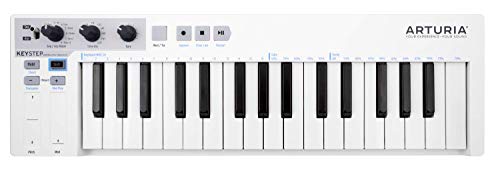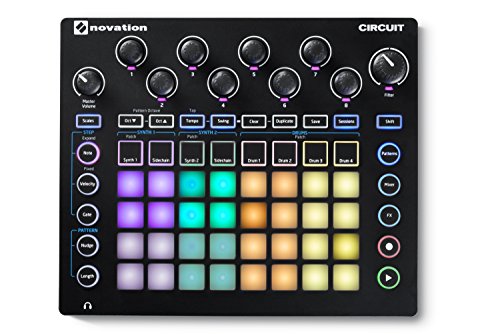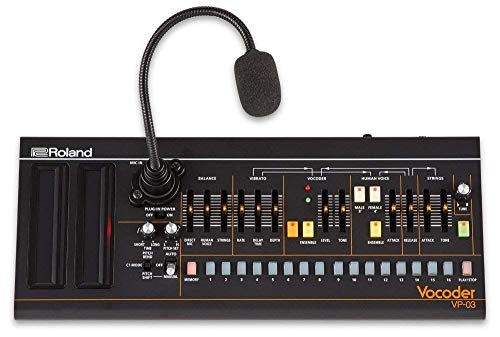The sequencer is an audio-interface which has seen many upgrades along the way, and changed how we control and create musical compositions.
In this article we aim to shed light on some of the best sequencers in 2025. They are top-rated and widely-available on the web. Modern sequencers are equipped with impressive processing powers, and make for a great digital remote to your chosen DAW.
Table of Contents
Whether it's for controlling your VST plug-ins, or capturing your own samples for toying around with, we have a few beauties up our sleeves. These will make life easier, and give users artistic license over their musical creativity, so let's crack on with our sequencer reviews.
At a glance: Our top 3 picks

Korg CV Sequencer and Sync Box (SQ1)

- Easy to use.
- Different modes.
- Reasonably versatile.

Arturia KeyStep Controller Sequencer

- Easy to use.
- Different modes.
- Reasonably versatile.
View The Best Sequencers Below
1. Korg CV Sequencer and Sync Box (SQ1)
First up is a surprisingly simple, but hands-on, 8-step sequencer for hooking to your synthesizer. It gives users two notes per step, and allows them to adjust the pitch or voltage of each note via a dial.
It has a well-thought-out configuration. The pads are made from good quality rubber and present a tactile feel - they're the same set from the well-loved Volca model. The light indicators help keep you visually informed mid-process.
This sequencer can be switched into other modes (active step, slide, and jump step), allowing for an expanded 16-note control. The Korg CV Sequencer is fitted with both a gate and a MIDI in and out function. You can only use them as an either/or functionality, which may be impractical for some.
Additionally, the Korg comes with USB MIDI and CV in and out connections. It has versatile compatibility and requires no set-up, as this is a plug and play device.
Pros:
+ Easy to use.
+ Different modes.
+ Reasonably versatile.
Why We Liked It - The Korg CV Sequencer is best for beginners as it drives just about any synth. The basic functionality keeps it straightforward.
2. Arturia KeyStep Controller Sequencer
This sequencer is a step-sequence controller from Arturia. It's competitively priced and, comparatively to the first, features a traditional MIDI keyboard.
The Arturia KeyStep has 32 slimmed down keys, which gives users polyphonic-step sequencing control. They have pitch-bend and modulation ribbon wheels, and plenty of options for tweaking your sound. Most notably is the built-in 'arpeggiator,' which is incredible.
This model features transport keys and can be used to control your DAW directly in totality.
It has CV I/O connections, as well as a USB MIDI, and is very well-constructed.
Pros:
+ Traditional MIDI keyboard sequencer.
+ Polyphonic sequencing.
+ Built-in arpeggiator.
Why We Liked It - The Arturia KeyStep has some great settings to play with. We prefer its piano key layout; the slimmer size allows for a few more keys to play with, but they are far-from-fiddly, unlike the mini-key option which sometimes presents a drawback.
3. Novation Circuit Groove Box
The Novation Circuit Groove Box is another impressive option which combines a 2-part synthesizer and a 4-part drum machine with a 4 by 8 step sequencer.
The innovative arrangement enables users to drop 16 spontaneously. It is excellent for quickly fixing an idea, and it can be used in real-time.
You can separate it into two separate sequences of 8, with the top set showing you previous sequences. Users can perform up to 128 steps sequentially with the Sample Flip, which enables 16 different samples per sequence over eight separate patterns.
The trigger pad quality is great, and the velocity sensitivity allows you to build drum patterns with a natural-sounding expressive quality to them. You can load up to 64 additional samples.
The two mono and polyphonic synths let you lay down everything, from bass-lines to chords to melody sections, using the pads or leads.
Each patch can be sculpted via the macro knobs. There are eight which can be tweaked to manipulate the pitch, tone, distortion, and the equalization blend, as well as the decay.
One of our favorite features is that it doesn't even need to be synced to your DAW, as the controller is battery powered. It's also full of drum samples and has adequate built-in speakers, meaning you can pick it up when an idea strikes.
Pros:
+ Drum machine/synth step-sequencer.
+ Range of adjustment controls.
+ Can be used independently.
Why We Liked It - The Novation Circuit is an intricate yet simple piece of kit to master. It provides a lot of playroom and covers all your sequencing needs.
4. Roland VP-03 Boutique Series
Our final model not only brings a great mix of mediums together, but it also gives users the ability to sequence vocal samples with its XLR connection for voice-step-sequencing.
The VP-03 is a scaled-down version of Roland's glorious, classic VoCoder. There are a ton of transformation options on-board, from the intelligible to the robo-ridiculous.
It's a polyphonic digital VoCoder that works on the company's ACB (analog circuit behavior). As well as being vocally capable, it contains a choir and synth string section.
It comes with an easily angled goose-neck mic that plugs straight in, but it's also compatible with any studio condenser or directional mic. We would recommend something with a much larger diaphragm for more wiggle room on how your voice transforms.
It has a balance section for mixing and a vibrato bar, as well as one for strings, choir, and vocals. You can switch between the sections by sliding the bar.
There are two touchpad-style ribbon sliders with an adjustable response; one which flattens or sharpens, and one for tempo.
The vocal section has a built-in male voice that can be layered poly-phonically into chords. The range can be widened with the chorus control.
The vibrato section gives users modulation options, utilizing the depth and rate sliders in conjunction with the rate control to contort the time, depth, and speed of the vibrato pulse.
It has additional controls for fine-tuning your attack, and tone control for filtering the brightness of your EQ.
All of this can be applied to the mic in real-time to transform your vocals. On top of this, it has a 16-step sequencer with tempo controls via the secondary ribbon slider.
The VP-03 is a hardy construction. You can connect it to an external MIDI keyboard, and it can interface with the majority of popular DAWS.
Pros:
+ VoCoder come step-sequencer.
+ Compact but elaborate.
+ Impeccable circuitry.
Why We Liked It - The VP-03 is a great digital homage to the analog vintage VoCoders which transformed the synth-music genres of eras gone by.
Sequencer Buyers Guide
What Is A Sequencer?
The term sequencer can refer to several things. They began life as analog manual sequencers, which were essentially synthesizer keyboards and rack mounts with programmable keys or switches. They allowed users to take a sample of anything and tweak it in a number of ways, which led to a lot of early experimentation.
After a bit of fun, people began to consider their practical functions more seriously.
Eventually, it became clear that being able to use them in a real-time sequence to program a beat, for example, with a range of percussive instruments dropping in and out at different beats, was far more useful.
Many sequencers broke away from keyboard keys, and we saw pads and other triggers replacing them. This led to early drum machines; then, the same principle was applied to synthesizer control. They allowed for the synthesizer to be controlled step-by-step. Thus, they became known as step-sequencers to distinguish the difference.
You can also get software sequencers, which are technically applications within software programs, usually in the form of a plugin.
Of course, your DAW will probably have a few of its own virtual sequencers, as this is how a beat is created within a program. Relying on your computer peripherals can be a problem for better command and control. It's generally accepted that connecting a physical sequencer is the best solution.
Power-sequencers are another type of sequencer you'll come across in a recording situation. They ease switching between different power outlet settings and protect your system from surges.
What to Look For in a Sequencer?
This is truly dependent on your musical needs. There is a range available on the market, and for the most part, they have a variety of applications.
Those we have highlighted all make for great solutions, and their abilities are pretty self-explanatory in terms of what you can use them for.
Conclusion
Sequencers have evolved alongside the more digitally focused music industry. There is a wealth around to choose from.
We've selected some great contenders with impressive capabilities, and in our research for the reviews, we've tried to be considerate of lower-budget buyers-as always.
Which sequencer to settle on is down to the individual. Consider how you work best, and what exactly you hope to get out of the addition to your peripherals.
We hope our buyer's guide has been an helpful read and wish you luck with your next purchase.
Expert Tip
If you're looking for a DAW controller that offers more than just step-sequencing needs, you may find our Best MIDI controller article very helpful.
Did you Know
The earliest form of sequencer could technically be considered the mechanical organs or player pianos, which played music in an automated fashion. In fact, some automated musical-box instruments with similar mechanisms date back to the 9th century, where water and steam-powered instruments were in use.
If you've enjoyed this review by Music Critic, please leave a positive rating:


